This is a follow on to the previous post talking about the types of sticky dorks and why they are declining in value in the cube. Rather than make that post even longer by extensively looking at individual cards I thought a series of top x lists would do the job best and break up the monotony of a wall of text! I have ranked these cards within their category but also given them an out of 10 rating so that they may also be compared to the cards on the other two lists.
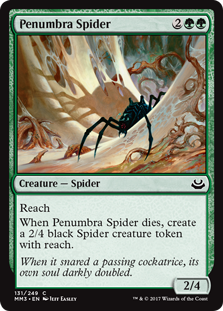
16. Penumbra Spider 3/10
What could be better than Giant Spider you ask? Well, two Giant Spiders of course! The penumbra series of cards was our first real offering of replacement dorks. In the very early days the Bobcat saw some play in cubes but being from Invasion power creep has hit them hard. None have really been playable for a long old time. The somewhat more recent throwback offering from Time Spiral however was a much more reasonably costed and useful front end. In cube this proved to be a solid defensive value card that would stave off loads of aggression very well. I think it was probably Courser of Kruphix that ultimately pushed it out and set a new bar for defensive dorks. Penumbra Spider never stopped being good, other better cards just rose up around it and left it no room to shine in. While I don't see this returning to cube glory I can see it doing good work in budget cube designs. I think it would surprise most people how annoying this is to play against and how good it still is despite a fairly booster draft feel to it.
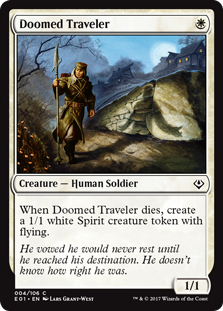
15. Doomed Traveler 3/10
This is a nice efficient little support card but it carries far too little weight to stand alone. Neither end of the card affords enough return to be worth the cost of the card and a mana. This can even be out performed by Suntail Hawk when you needed that flier up and running right away and you don't see Flying Man played in any colour these days. The occasions that Traveler starts to shine are where you have sacrifice costs to pay and ideally creature buff effects as well. It is one of the better support cards in black white tokens. White offers good boosts to the tokens while black offers some nice things to cash in on them with. More over there are very few good token style cards in the one mana slot further increasing the value of this support tool. The addition of Intangible Virtue and a Cabal Therapy turn this into a very potent one mana play indeed! This is one of those cards that is fairly useless unless it is in the ideal deck at which point it becomes incredibly strong and often one of the better cards in the deck.
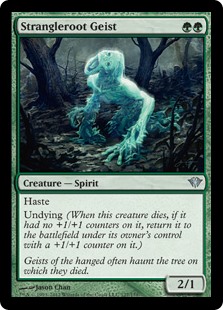
14. Strangleroot Geist 4/10
This is an odd card in terms of how it has done in cube. It is the victim of the decline in value in sticky dorks more so than most but a large part of this is down to the meta. Most other colours would be all over this card, it is the fact that it is green that hurts it so much. It is odd that it has fallen off in power so greatly as it was and probably still is one of the highest tempo replacement dorks both overall and in its front end. The issue is not with the tempo or the power level. It is that the only archetypes that want this card are creature based green aggressive decks. That is basically only Zoo and Zoo being any colour you fancy is so utterly spoiled for choice that this is just one of many strong two drop options. A while ago you might have thrown this in a green ramp deck or a midrange rock deck both to stall out the game against aggression or to apply pressure and tax control. These days you have far better options and so this only goes in the one deck to which it is most well suited. The other real issue for this card is that it is pretty low threat level. A 2/1 is very easy to ignore and leave till last and a 3/2 is hardly back breaking. It get killed in combat by most things and is basically just board filler. Strangleroot was a premium green two drop when it first came out and has steadily declined since then to the point where I don't think it is all that exciting.
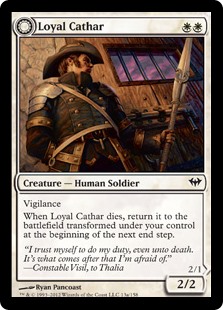
13. Loyal Cathar 4/10
This is another one of the fairer replacement cards that has gotten steadily less exciting like Strangleroot. Cathar has held on a bit better despite being substantially lower power level. Mostly this is to do with theme. White often wants to flood the board with cheap dorks and really wants to keep as many of them there to attack with as possible. White aggressive decks hate mass removal and are much better than green aggressive decks on the whole. Human creature type has been a big help for this card as has transitioning from Honour the Pure / Crusade effects to Glorius Anthem ones. Cathar is also slightly better against flicker and bounce than the token producing cards on this list as it stays as a physical card. Ultimately it is just getting pushed out by substantially more powerful cards coming in around it. It is fine on theme filler but the good aggressive decks are less and less filler cards these days. Double white is a big turn off for a filler card as well as it makes it substantially narrower in where you might want to play it.
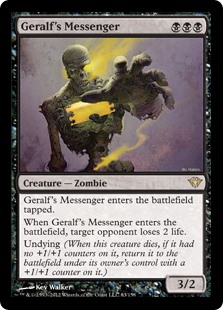
12. Geralf's Messenger 5/10
This is a card I find hard to rate. It has quite a monstrous power level as well as lots of good synergies one the one hand and on the other it is designed to be on the awkward side and is so hard to cast that it is one of the narrower cards on this list. You have to be super heavy black to even consider this. It is not far off a mono only card. This has a bit of the Doomed Traveler to it in that you need specific conditions to make use of it. Unlike Traveler however the Messengers is absolutely worth the card and mana you spend on it and it does plenty all on its own. My experience playing with and against this is that it forces the race in most cases. It is such a huge disincentive to try and work through it the long way combined with the fact it comes in tapped. People just look at the board and the only half good option seems like going sideways. Even exile removal is not a total disaster as you still did them two, only paid three mana for your card, you went one for one and you baited a premium removal spell. You may even have gone two for one if you got a clue or a land. Messenger's fits perfectly into devotion decks as he is cheap, sticky, reasonably well rounded and offers maximum devotion for the mana. He is also decent in zombie decks although he is just a good card with the zombie tag. It might well be the case now that you want lords and other synergy cards for your zombies in a tribal build. Given that the best devotion payoff card in black is a zombie (Grey Merchant) you often see those strategies combined and then Messengers jumps to one of the first names on the team sheet.

11. Woodfall Primus 5/10
I only ever play this now if I am cheating it into play somehow or if I have a terrible terrible deck. For eight mana this simply doesn't do enough to swing a game. Killing one non-creature thing and providing a single 6/6 blocker is not the devastation I desire for 8 mana. I want to win the game with a Craterhoof Behemoth or at least clear their board and have an Ugin left in play. Primus is a good value dork but you are not looking for value at 8 mana. Scaled back in some way to somehow make it a 4 or 5 mana card and it would probably be nuts. At 8, even with potent green ramp, I am only really happy with this card when I get to Sneak Attack it into someones face or when I can Shallow Grave it and then sac it post combat. A simple Exhume can also be plenty good enough if you do it sufficiently early that destroying a land is a big deal. While you can easily play this in a green ramp deck and will sometimes have to it is simply not enough payoff to be good. You are investing so much of your deck into ramping that you need those few big mana cards you can run to really carry which this doesn't do. It doesn't stop enough pressure, answer enough problems or pose a significant enough threat itself. Once upon a time this was playable top end but now it is basically just part of a combo.
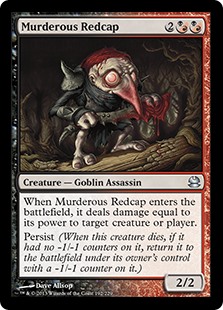
10. Murderous Redcap 5/10
A great little card that has seen a surprisingly small amount of play given its quality and potential abuse. A lot of this is down to it being a bit too pricey for a lot of red decks to get interested and a little outclassed by the mono black 187 dorks like Skinrender, Shriekmaw and the like. The most common place to see this is in Birthing Pod decks and Goblin decks where they would commonly use it as a good thing to sacrifice. Redcap has seen some play as a stall tool for control decks but he is pretty mediocre at it. Redcap is far more about the EtB ability than the body. While the persist is good both the 2/2 and the 1/1 do very little to improve your board. The shock and the ping are great but they are a lot less useful to control at the four mana mark as it is typically only able to kill cheaper things. Control decks want removal options to be as cheap as possible relative to the things they are killing and Redcap fails that test pretty hard. While this card very much has its roles in cube I think it is now, much like Woodfall Primus, a combo and synergy card exclusively and not something that you really want to just play because it is just good.
9. Carrier Thrall 6/10
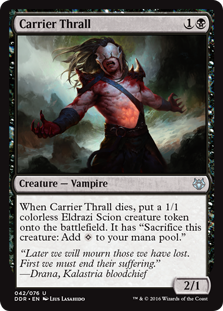
This is a low powered card for sure, arguably lower powered than Loyal Cathar! Despite this it has put in an impressive showing in the cube so far and has not fallen off nearly as much as some of the others. This is a cheap pair of bodies to chump or sacrifice like Doomed Traveler yet it is already in the colour that wants sacrificial bodies and it comes with sufficient power to make it relevant on its own. The ramp aspect is useful as well and gives the card a broad range of utility. I have thwarted Mother of Runes dominance over a game with my colourless eldrazi scion! I have saced it before combat damage to deny lifelink and Jitte counters. I have turned this card into four with Skullclamp. I have merely traded with a one drop and then ramped out a four drop. This card is fine filler in aggro and great stall and utility in slower decks. As you get more things that have synergy with it the value of the card increases fairly impressively. One of the huge things propping this card up is that black basically only has this and Seeker's Squire as good all round value two drops. If you want a black midrange dork at two mana then this is one of the cards you look to.
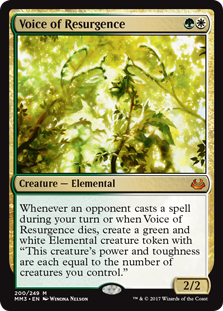
8. Voice of Resurgence 6/10
Time to jump to an immensely powerful card. Despite being gold this is less narrow than Messengers and it is certainly more powerful. The total board presence this gives is rather greater than Messenger's, mostly because it all comes in untapped. Being green white the token does tend to get pretty out of hand pretty fast. The combined front and back ends of these cards on average likely favours the Voice over the Messengers. It is a mana cheaper than Messengers and it also has a hate bear mechanic! It is dangerous enough that it pretty much shuts off instants. If you Armageddon you might still bait out a counterspell but in most other cases if they are triggering this they are either broadcasting their Wrath or they are in desperation mode. Just turning instant speed removal into sorcery speed removal against say a Jund deck is a big deal too. It gives you much greater comfort to get into combat on your turns. Voice is a total all rounder. It is disruption, it is value and it is tempo. Some decks can ignore it for a long time but they will usually have to eat two in the face every turn rather that kill it in combat as the token will be the biggest thing on the board! The things that keep Voice in the realms of a fair cube card are the fact that green and white have all the best cheap dorks. If you play this you are cutting something comparably strong to do so. Green white is also not an especially common or strong pairing to go in cube.
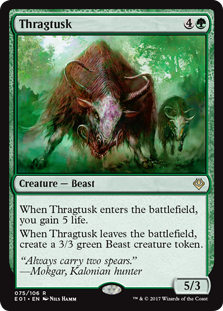
7. Thragtusk 6/10
The real strength of Thragtusk is that it works when it leaves play rather than as a when it dies trigger. That means bounce, reshuffle and exile all still trigger this. Basically, once Tusk is down there is no preventing that 3/3 short of a Stifle effect! The card is sort of a countermeasure to red decks mostly these days. Without the five life holding significant value the card is actually pretty awful. For five mana neither the value, nor the tempo, nor the threat level really come close to what cube can do. Tusk is a total of 8/6 stats, pretty poor compared to a Wolfir Silverheart, Ishkanah or Verdurous Gearhulk. You never need more than 3 damage to kill it either making it a pretty poor card for trying to win with. It can't get past a Blade Splicer...Tusk is great against burn, it is nice to abuse with flicker effects and Recurring Nightmare but outside of that it is not so impressive. It is a five mana card that performs the role of what you want a three drop to do. To play it you have to cut a card that is actually a good threat or source of value.
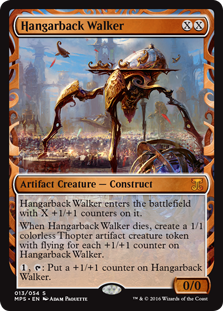
6. Hangarback Waker 6.5/10
This little card is certainly a pretty fair card in isolation. It is low tempo and a typically slow card. It still makes for fine all round filler in a surprisingly large number of decks but a reasonable portion of it's value as a filler card is that it is both a fine enough 2 drop and a fine enough 8 drop. It is a supporting card by nature but it is curve filler across the board and is a card you can put towards you tally of threats. Where Hangarback starts to get more exciting is when you have synergies with it. Typically those are artifact matters cards or +1/+1 counter shenanigans. It can also be sacrifice mechanisms or just global buffs too. There are a lot of things that can make good use of this little artifact in all the colours. Being a replacement dork they will not that keen on killing it but the longer it sits around the more chance there is of it growing and becoming too dangerous to pop. While a terrible up front tempo play regardless of the value of X you can do a lot to quickly change that, particularly on the smaller Hangarbacks. You think all is well and you can handle a couple of 1/1 fliers and then they flop and Nissa and a Rishkar and the Hangarback is suddenly beating down hard and casts a Lingering Souls when it dies!
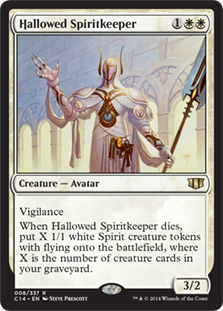
5. Hallowed Spiritkeeper 7/10
Speaking of cards that cast Lingering Souls when they die... This is the white only tempo version of the Hangarback. Spritkeeper has a body twice as big as a Hangarback relative to cost and requires no investment in it to scale up the tokens it will produce. Spiritkeeper is a total house, it is cards like this that greatly reduce the value of chaff like Loyal Cathar. Who wants a 2/1 when it dies when you can win the game if it dies instead. People often underrate this card on the assumption it counts things in the bin prior to when it would die not "after" so to speak. If you have it and 3 other dorks in play and two dorks in the bin then when they cast Wrath of God you will get six 1/1 fliers and not two or even five. If you have just it and an otherwise empty board and yard you still get a single 1/1 which is still probably more use than Loyal Cathar! Spiritkeeper is one of whites best anti mass removal tools. You have to remove this from play first and then Wrath. You also have to do it as quickly as possible to minimize the spirits unless you are bouncing or exiling it. This is super tedious to play against and super safe to play with. The Vigilance is also far more relevant than usual as this is a card they often cannot afford to kill in combat. As such it can get in for 3 free damage and hold off a lot of their swing back potential. All in all this card is pretty silly. It is a touch clunky but well worth it. It is also a touch narrow being double white and scaling with creature count. This is a fine card in a midrange or agro deck but control is probably getting more out of a Hangarback. Spiritkeeper is the first of the cards on this list that I would consider to be properly powerful and scary cube cards.
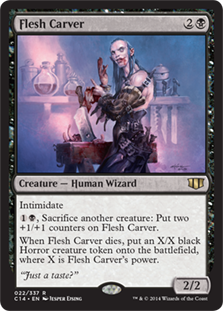
4. Flesh Carver 7/10
Arguably Spiritkeeper is a better card than this in raw power terms. Spiritkeeper certainly has a better final form! Flesh Carver on the other hand is far more rounded and playable. Not just for the cost but also for the various things he offers. An instant sac outlet, the ability to grow at instant speed and evasion. All of these things make Flesh Carver all round awkward to handle. He can simply win games by being unblockable or by being the biggest thing on the board. Spiritkeeper often feels like a card you play to counter mass removal a bit like Selfless Spirit. Flesh Carver is something you can play as a threat and he is pretty good at it while also being pretty good against mass removal too. He might not protect your other dorks from it but he can somewhat recycle them! He is a royal pain to try and play planeswalkers into. He is usually enough to bait out premium exile removal. Like Spiritkeeper he does scale with your creature count, he also scales with things that are good to be sacrificed. This is a card I want in any sort of midrange deck and most aggro decks too. I have played him in control too though it was in a hole I much rather would have had an Ophiomancer or the like.

3. Glen Elandra Archmage 7.5
For some reason this card feels like a hard lock all by itself! You can abuse some synergies to afford you as many Negates as you have blue mana for but you don't really need to. Once this comes down spells are not how they are winning the game. Even premium exile removal doesn't stop the two for one from this card as you just get it countered! You have to run two relevant spells into this to be able to resolve a relevant spell and that makes this the bane of many decks. It is more of a five drop than a four drop but you can be enough ahead that one counterspell will seal the deal so just running it out is fine. This also isn't the worst card defending against creature pressure. It flies and has two lives at least! I have certainly held back Lingering Souls with this for a good while. More relevantly than its capacity to block is its ability to attack. A resistant flying 2/2 will chip away at life totals and potentially loyalty counts. It might not be quick but the threat of Negate does tend to slow down a lot of games. Her ability to threaten walkers does mean that some of the less able to protect themselves wont even bait one of the Negates. Garruk Wildspeaker is either a Hill Giant token and two life or a Hickory Woodlot(ish) and six life in the face of a 2/2 flier which makes him probably not too important to Negate. Although one of the best cards against control decks in the cube it is also a card control decks often want themselves. It is insane in the mirror, a two for one counterspell is good but having hard counters at one mana is what really allows for the power plays.
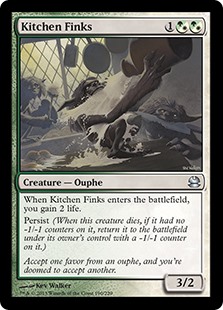
2. Kitchen Finks 7.5
This is the card I think of when I think of sticky dorks. While still very much one of the best sticky dorks it has not been immune to their general decline in value. This would have been number one on this list since it was printed until very recently and would probably have had a 8.5 or higher rating out of ten. Finks is a fantastic anti aggro card, it is what Thragtusk wants to be! It is also just a pain for control and midrange decks. It isn't threatening so much as annoying. The strength of Finks is not in how good the card is in isolation but that it is pretty good all round and the best in the business at going head to against red aggressive decks. The decent exile burn, Pillar of Flame and Incendiary Flow, and even the lifegain prevention cards red now has some reasonable access to have all helped reduce how good Finks is against them which in turn has hit the average performance of the card. When much of its prowess was in countering the best deck and it does that less well the fact that it is just a fine card in other matchups starts to be more of a drag on the card. The card is still great, I don't want to sound like I am beating up on it too hard. It is flexible in where you can play it due to hybrid mana, it is one of the most front loaded sticky dorks on offer, it performs multiple roles and has a number of good synergies too. It is getting less play in aggro and control decks than in the past but it is still a mainstay of midrange and not a stranger to the combo side of life!
1. Wurmcoil Engine 8/10
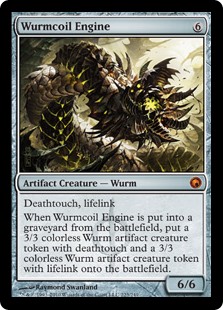
Much as I am a bit against this as the number one slot it certainly earns it in how much it gets played, how high it is picked and how often if simple makes people pick up their cards. This is super easy to cast and powerful enough to be worth cheating into play. It is common place to see this in ramp decks and control decks as well as the top end of a midrange deck. Finks is low enough impact than a red deck can play around it or through it and still win even when it doesn't have the perfect answer. Wurmcoil connects with anything once and that is usually game over. You need specific answers to it such as Abrade plus 3 damage for the lifelink token and they are never favourable trades for red. It is super common for Wurmcoil to force plays like burning your own blocker so that the lifelink doesn't trigger and you get an extra turn to try and win in. Wurmcoil shuts down most attacks as well so despite not technically having an immediate impact on the board it generally feels like it does. It is near impossible to race a Wurmcoil for any archetype and hard to trade with it in a way that doesn't generate them loads of value. It is a great source of lifegain to colours that don't have it. Being such an expensive card you do run some risks with the Engine. You will pretty much immediately draw any exile removal your opponent has unless they happen to have a way to steal it from you! If you invest six mana in a thing that gets dealt with cleanly for just a couple then you lost a lot in that exchange. You probably just gave them a safe window to play that planeswalker and start milking it for value. In those kinds of games however you are not under time pressure and so you just have to be a little bit careful about your Wurmcoil and not just slam it down as soon as you can assuming it beats every archetype as hard as it beats the aggro red decks.